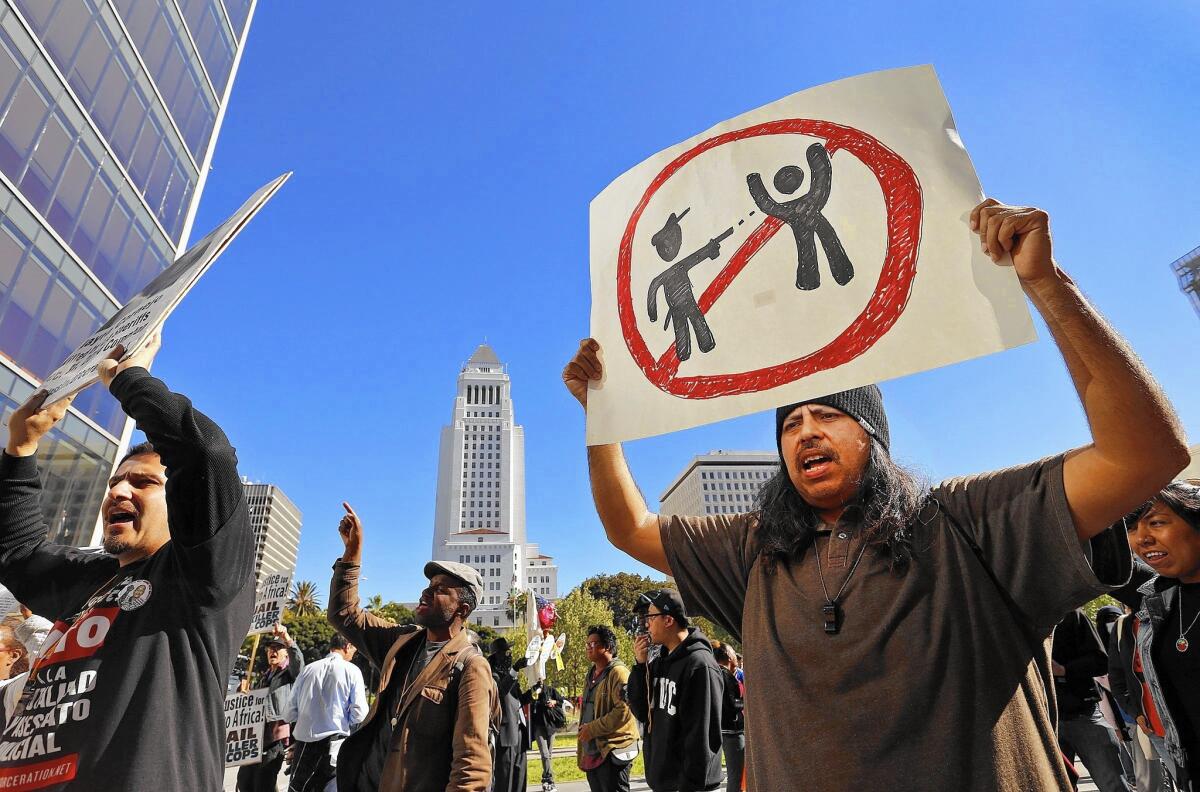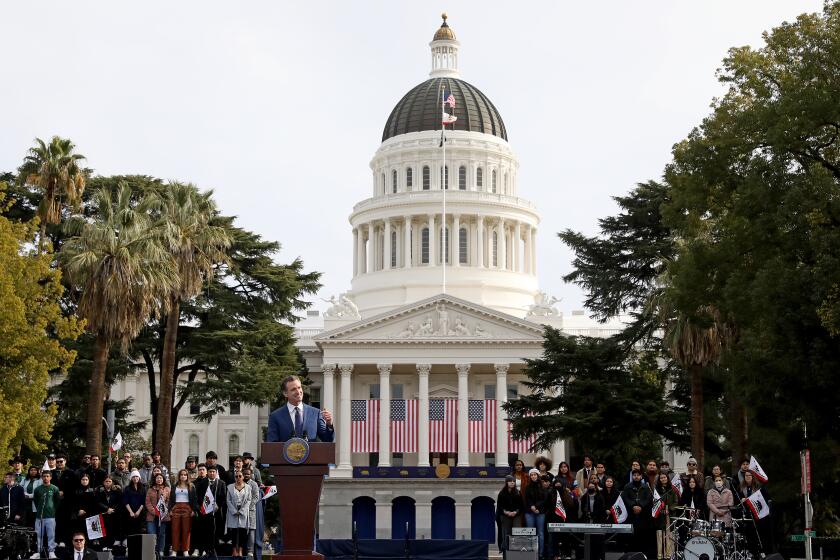10 years later, L.A.’s skid row remains an urban dystopia

- Share via
On a cool, drizzly day 10 years ago, I met a lonely, afflicted soul in downtown Los Angeles who would eventually take me to places I’d never visited. Disney Hall, for instance, and the White House. And to the depths of skid row.
Nathaniel Ayers survived on music, memories and a dream that with practice and dedication — along with inspiration from the Beethoven statue in Pershing Square — he might one day get “back on track” as he called it. Skid row was a repository for thousands of people who had veered off the tracks, and I had never seen anything like it.
Every manner of human suffering and social breakdown was on full display in this teeming colony of the destitute and the desperately ill. I saw people in the grips of full-blown psychotic breakdowns. Sirens wailed and drug dealers ruled, and prostitutes escorted clients into their port-a-potty parlors a block from the police station. My friend Nathaniel, diagnosed with schizophrenia as a young man, crushed cockroaches to clear a space for his bedding at night and used sticks to ward off rats.
Then-Mayor Antonio Villaraigosa called me to say he was reading my daily columns on skid row conditions and wanted to make the rounds with me. One night, in an area where heroin addicts tended to gather on one side of the street and crack addicts on the other — many of them medicating against the horrors of mental illness — the mayor and I watched a man drive a hypodermic into the crease of his arm.
Villaraigosa said he was going to “take on the challenge” of addressing what then-Police Chief Bill Bratton called “the worst situation in America.” Bratton added: “And we should be ashamed.” Several months later, at the Midnight Mission, public officials gathered to announce details of a 10-year-plan to end homelessness.
Well, we know how that worked out. Among other problems, five planned regional service centers were dead on arrival because nobody wanted one in their neighborhood.
Last Saturday, I was back at the Midnight Mission with my daughter and her classmates, who were serving lunch as part of a school project. The hungry and the sick huddled at the door by the hundreds, then filed in for a bit of sustenance before returning to their tents and cardboard encampments.
Then on Sunday, less than a block from the Midnight Mission, police officers shot and killed a homeless man during a struggle. This drew a spotlight not just on the use of deadly force, but on the enduring calamity that is skid row.
I can’t yet judge the shooting. The victim reportedly was a convicted bank robber with mental health issues, and police claim he went for an officer’s gun. I will say that even with mental health training, cops are not clinicians and can’t be expected to fix problems created by decades of public policy failures.
As for skid row, there are still days when I’m as shocked as I was 10 years ago.
Even if the population is smaller than it was back then, as some suggest, there seems to have been a recent resurgence. The Rev. Andy Bales, director of the Union Rescue Mission, thinks things are out of hand.
“There are more encampments than ever, more violence and a higher percentage of severely mentally troubled people,” Bales said.
No matter how many times I walk the streets, I still can not believe I’m in a civilized society, let alone the richest nation in history. It’s as if there’s been a war or natural disaster, and the wounded, shellshocked and penniless have been herded into a dystopian holding pen where they have nothing left but a small measure of their self-respect, plenty of company and countless temptations to sink even lower.
A few dozen people milled about Tuesday morning on the street where the homeless man died Sunday. There were taunts and rants, and encampments as far as the eye could see, and although there are definitely some violent people on the row — as I passed, two of them got into a fight and wrestled each other to the ground — there’s a far greater prevalence of sick people, some in wheelchairs and on crutches.
You keep waiting for someone to show up and say wait a minute, this is not OK. But the only trace of indignation is monetary in nature, not moral. Skid row stands in the way of more gentrification.
Campaigns to cut the ranks of homeless have enjoyed some success in Greater Los Angeles. Service providers by the hundreds do noble work with a population that can be help-resistant, and thousands have been housed in the last 10 years. But the financial crash was no friend to good intentions because money for proven services diminished just as people lost jobs and homes.
The problem, in three words, is this:
Demand outpaces supply.
And so skid row teems with the overflow of those who are physically or mentally sick, or addicted, or impoverished, or damaged by war, or all of the above.
“I think ultimately it says more about the rest of us than about the people on the streets,” said Mike Alvidrez of the Skid Row Housing Trust.
What makes this all the more tragic is that some of the solutions are obvious.
More permanent supportive housing could save taxpayers money in the long run because visits to court, jail and hospitals are ridiculously expensive. More crisis beds are needed too, and a speedup of efforts to divert sick people out of jail and into rehabilitative services. And there should be more specially trained teams of police officers and mental health professionals, available round-the-clock to respond to crisis calls.
Mollie Lowery of Housing Works, who has been a service provider for decades, says it simply is not OK for any of us to accept that someone who’s desperately ill should be left to fend for themselves. She said there has to be more and smarter outreach that removes barriers to care rather than erecting them, no matter how sick the person might be or how long it takes to earn their trust and deliver the needed help.
(Full disclosure: Lowery, her staff and I have teamed up for a couple of years now — with an assist from the Los Angeles County Department of Mental Health Services — to get the best possible care for my friend Nathaniel. At the moment he’s doing extremely well under a psychiatric commitment).
As I was saying, we know what works, and here’s an example:
On the same street where the homeless man was killed Sunday, a formerly homeless man named Eddie Givens lives in a Skid Row Housing Trust apartment.
I’ve written previously about Givens, who called himself a “blackout drunk.” He had been homeless for about 30 years and was arrested and hospitalized dozens of times. Then, in 2007, he was deemed one of the 50 sickest people on skid row and was given an apartment, entered rehab and got psychiatric care for a condition that had been untreated.
Givens thrived in Project 50, a program that proved the cycle of homelessness can be reversed.
“You have to do some work, but it can work for you if you really want it to,” Givens told me when I dropped by Tuesday morning. “I’m a witness to that.”
The only problem with Project 50 was that we really need a Project 5,000.
Ten years ago I met a man who helped me recognize that those are our brothers and sisters out there, our sons and our daughters, and they all have stories. Many of them landed hard, some of them through no fault of their own, and we can’t leave anyone behind.
More to Read
Sign up for Essential California
The most important California stories and recommendations in your inbox every morning.
You may occasionally receive promotional content from the Los Angeles Times.











